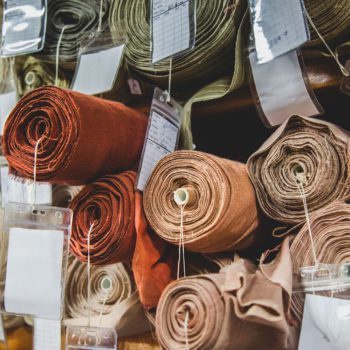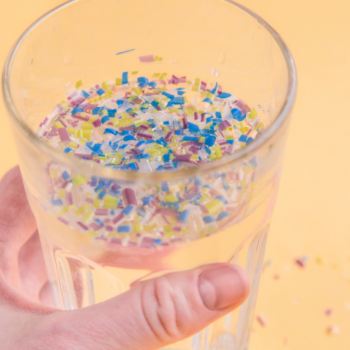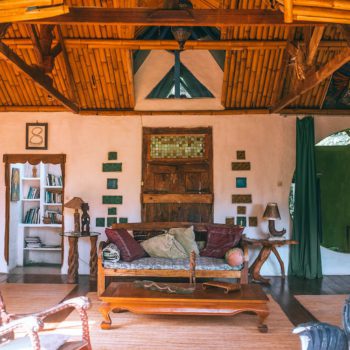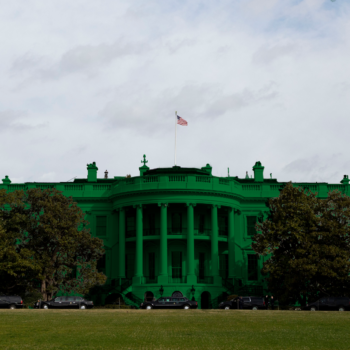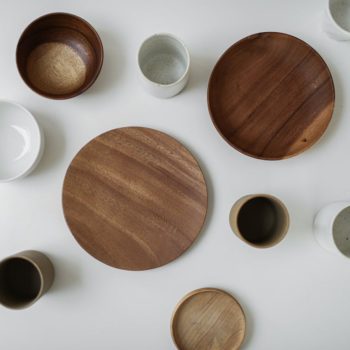|
|
Upcycling is an excellent sustainable solution for eco-conscious fashionistas today, where fast fashion dominates and landfills are overflowing. This practice goes beyond sustainability—it’s a celebration of creativity and uniqueness and a move towards a more thoughtful and individualistic approach to fashion.
Upcycling transforms previously owned or discarded items into something of higher quality or value. By breathing new life into old garments, you can create unique pieces that reflect your personal style while reducing your environmental footprint.
In this guide, we’re diving deep into the world of upcycling, particularly how it intertwines with fashion. We’ll start by examining the fast fashion industry and its environmental impact. We’ll then define upcycling and discuss its significance in the fashion industry.
Ready to get creative? We’ve also gathered 11 easy DIY tricks to transform your wardrobe with upcycled fashion, showing you that combining style and eco-friendliness is possible.
But what if your upcycled creations could do more than upgrade your wardrobe? Could you potentially sell them? Moving further, we’ll explore the possibility of selling upcycled clothes and dive into the legal considerations you need to know.
Let’s navigate through the ins and outs of upcycled fashion and prove that sustainability and style can indeed walk hand in hand with a bit of creativity.
Key Takeaways
-
- Upcycled fashion is an eco-friendly alternative to fast fashion, reducing textile waste and environmental impact.
-
- Understanding the principles of upcycling empowers you to transform old garments into unique pieces with creativity and skill.
-
- Incorporating upcycled fashion into your wardrobe is easy and cost-effective, requiring only basic sewing skills and a dash of imagination.
-
- Selling upcycled clothes can be a rewarding way to share your creations with others while also contributing to environmental sustainability. However, it comes with its own challenges, especially regarding legal and safety regulations.
Fast Fashion and Its Environmental Impact

To truly appreciate the value of upcycling, it’s essential to understand the backdrop against which it stands out: the fast fashion industry.
Fast fashion refers to rapidly producing inexpensive clothing to keep up with ever-changing trends. However, this trend comes at a cost to the environment and workers in the fashion supply chain.
According to studies like the one by McKinsey, in 2018 alone, the fashion industry was responsible for emitting approximately 2.1 billion metric tons of greenhouse gases (GHG), which accounts for about 4% of the global total. To put that into perspective, the fashion industry’s yearly emissions are roughly equivalent to the combined annual GHG emissions of France, Germany, and the United Kingdom—three of Europe’s largest economies.

Image Source: https://www.mckinsey.com/~/media/mckinsey/industries/retail/our+insights/fashion+on+climate/fashion-on-climate-full-report.pdf
The environmental challenges posed by the fashion industry extend well beyond emissions. A significant concern is the industry’s contribution to global wastewater; around 20% of worldwide wastewater originates from textile production and processing. This polluted water, often containing hazardous chemicals from dyeing and treating fabrics, can contaminate rivers, oceans, and soil, harming aquatic life and ecosystems.
Furthermore, the lifecycle of clothing under the fast fashion model exacerbates waste issues. An astonishing 85% of textiles end up in landfills or are incinerated yearly. This represents a massive waste of resources and contributes to pollution and further greenhouse gas emissions, as synthetic fibers, like polyester, can take hundreds of years to decompose.
Add to those issues are the ethical questions the industry raises concerning labor practices. Many companies outsource production to countries with lower wages and less stringent labor laws to keep costs down, often leading to exploitation and unsafe working conditions. The European Parliament has starkly described conditions in some garment factories as akin to “slave labor.”
The figures above highlight an urgent call for change within the industry, propelling movements like upcycling, which seeks to counteract the environmental damages of fast fashion by promoting more responsible production and consumption habits.
As awareness grows, consumers and producers increasingly recognize the importance of transitioning towards sustainability to mitigate the fashion industry’s impact on climate change.
Understanding Upcycling: Definition and Application in Fashion
Upcycling is the process of transforming old or unwanted materials into new products of better quality or value. It stands out distinctly within waste reduction and sustainable fashion by offering an innovative alternative to disposing of materials.
Unlike textile recycling, which involves breaking down materials into raw forms to create new ones, upcycling involves a transformational process where the original materials are not broken down but reimagined and redesigned into products with greater value, quality, or use.
In the context of the fashion industry, upcycling is particularly compelling. It involves taking garments or textile materials that are no longer in use—whether due to being out of fashion, slightly damaged, or simply unwanted—and transforming them into unique, stylish pieces. This could mean altering a dress into a chic top, combining fabrics from several old clothes to create a new garment, or adding embellishments to refresh a dated look.
A Look Into Upcycling Fashion History
While the term “upcycling” has gained popularity in recent years, the concept of repurposing materials in fashion dates back centuries.
Historically, people would mend, alter, or repurpose their clothing out of necessity, often due to limited resources or economic constraints. However, the modern upcycling movement in fashion began to take shape in the late 20th century as a response to fast fashion’s environmental and social impacts.
In the 1990s, as concerns about sustainability and waste grew, designers and activists started to explore alternative approaches to fashion production. Upcycling emerged as a solution to the growing problem of textile waste, offering a way to divert discarded garments and fabrics from landfills while creating unique and environmentally friendly clothing.
One of the pioneers of upcycled fashion was British designer Katharine Hamnett, who gained fame in the 1980s for her politically charged slogan t-shirts. In the 1990s, Hamnett began incorporating upcycled materials into her collections, experimenting with vintage fabrics and repurposed garments to create new designs with a sustainable twist.
In the early 2000s, upcycling gained traction as a mainstream trend, with designers and brands embracing the concept as a way to differentiate themselves in an increasingly competitive market. Upcycled fashion became associated with creativity, individuality, and ethical consumption, appealing to consumers seeking alternatives to mass-produced clothing.
Today, upcycling has become a central tenet of the sustainable fashion movement, with a growing number of designers, brands, and consumers embracing the practice to reduce waste and minimize the environmental impact of clothing production. Upcycling inspires creativity and innovation in the fashion industry, offering a glimpse of a more sustainable future for fashion, from small-scale DIY projects to high-end fashion collections.
Benefits of Upcycled Fashion
Upcycled fashion brings multiple benefits that span environmental, economic, and personal dimensions. Here’s an exploration of why upcycled fashion is gaining momentum and how it is making a positive impact:
Environmental Benefits
-
- Reduces Waste: Upcycling tackles the issue of waste by transforming old or unused textiles into new garments, diverting them from landfills and extending their lifespan.
-
- Conserves Resources: By utilizing existing materials, upcycling reduces the demand for new resources like water and energy, thus conserving precious natural resources and minimizing the environmental impact of textile production.
-
- Reduces Carbon Footprint: Upcycling minimizes the need for manufacturing and transportation to produce garments, reducing greenhouse gas emissions and mitigating climate change.
Socioeconomic Benefits
-
- Promotes Circular Economy: Upcycled fashion fosters a shift towards a circular economy, where resources are used for as long as possible, promoting sustainability and minimizing waste.
-
- Supports Local Economies: Many upcycling initiatives are rooted in local communities. They support small businesses and artisans by allowing them to showcase their creativity and skills, thus contributing to local economic development.
-
- Creates Job Opportunities: The growth of the upcycling market can lead to the creation of new jobs within the fashion industry, particularly in sectors focused on sustainable and ethical fashion, thus contributing to economic growth and employment.
-
- Encourages Innovation in Design: Upcycling challenges designers to innovate with limited resources, leading to unique and avant-garde fashion statements that push the boundaries of creativity and sustainability.
-
- Enhances Awareness and Education: Upcycled fashion serves as an educational tool, raising awareness about the environmental impact of the fashion industry and inspiring individuals to adopt more sustainable practices through workshops, social media, and community programs.
-
- Builds Community: Upcycling fosters a sense of community among individuals who share a passion for sustainability and creativity, providing opportunities for collaboration, learning, and connection.
-
- Supports Ethical Fashion: Upcycling aligns with the principles of ethical fashion by reducing waste, minimizing environmental harm, and promoting fair labor practices, thus offering consumers a more ethical and sustainable alternative to conventional fashion.
Personal Benefits
-
- Fosters Creativity and Individuality: Upcycled fashion empowers individuals to express their unique style through one-of-a-kind pieces that reflect their personality and values, encouraging creativity and self-expression.
-
- Encourages Mindful Consumption: Engaging with upcycled fashion encourages individuals to rethink their consumption habits, prioritizing quality and sustainability over quantity, thus promoting a more mindful approach to fashion consumption.
-
- Offers Affordable Options for High-Quality Pieces: Upcycled fashion provides access to high-quality, durable garments at lower prices than new, sustainably produced items, making sustainable fashion more accessible and affordable to a broader audience.
11 Ways to Incorporate Upcycled Fashion Into Your Wardrobe

Incorporating upcycled fashion into your wardrobe is an exciting way to refresh your style, support sustainability, and engage with the creative side of clothing. Here are 11 ways to upcycle clothes and accessories that will get you started on your upcycling journey:
1. Denim Patchwork
Denim patchwork offers a fantastic opportunity to breathe new life into an old pair of jeans, giving them a second chance to shine in your wardrobe. Begin by raiding your closet or hitting up thrift stores for a diverse selection of denim. Look for jeans in varying shades, textures, and even patterns to add depth and character to your patchwork creations.
Once you have your denim collection, unleash your creativity by envisioning unique patchwork designs. You can opt for traditional square or rectangular patches for a classic look or experiment with geometric shapes, asymmetrical patterns, or even whimsical motifs for a more eclectic vibe.
Mix and match different denim pieces to create visually striking compositions, balancing light and dark washes, distressed and intact fabrics, and even incorporating denim with varying textures like corduroy or chambray.
The beauty of denim patchwork lies in its versatility. You can use your patchwork panels to create a wide range of stylish and functional items, from trendy skirts and statement jackets to sturdy tote bags and eye-catching pillow covers. Let your imagination run wild as you explore the endless possibilities of denim patchwork, turning old jeans into fashion-forward pieces that reflect your unique style and personality.
2. Dyeing Techniques
Experimenting with fabric dyes is a fantastic way to inject a burst of color and personality into your wardrobe while prolonging the lifespan of your favorite garments. Whether you’re reviving faded pieces, giving new life to an old t-shirt or other unloved items, or adding a pop of color to plain fabrics, the possibilities with fabric dyeing are virtually limitless.
One popular technique is batik, a traditional method that uses wax to create intricate patterns on fabric before dyeing. By selectively applying wax to areas you want to remain untouched by dye, you can create stunning designs with rich layers of color and texture. Batik allows for endless creativity, from geometric motifs to organic patterns inspired by nature, making each piece unique.
Tie-dye is another beloved fabric dyeing technique that has stood the test of time and is beloved for its playful and psychedelic aesthetic. With tie-dye, you can transform plain white garments into vibrant works of art by twisting, folding, and securing fabric before applying dye. The result is a mesmerizing array of swirls, spirals, and bursts of color that evoke a sense of whimsy and free-spiritedness.
Similarly, ombre dyeing gradually transitions from one color to another, resulting in a subtle and sophisticated gradient effect that adds depth and dimension to any garment. Whether dip-dyeing a skirt for a beachy ombré look or hand-painting a blouse for a custom ombré effect, this technique allows you to play with color in subtle and stunning ways, elevating simple garments into authentic statement pieces.
Your Weekly Sustainability News!
By subscribing you agree to our Privacy Policy
3. Sewing Projects
Basic sewing skills are valuable for anyone looking to customize their wardrobe and breathe new life into old garments. Whether hemming pants for a better fit, repairing a torn seam, or adding embellishments to a plain shirt, sewing allows you to take control of your clothing and make it uniquely yours. Do simple alterations, such as taking in a waist or shortening sleeves, to transform ill-fitting items into perfectly tailored pieces that flatter your figure and boost your confidence.
Moreover, sewing offers endless opportunities for creative expression. From delicate embroidery to bold appliqué, decorative stitches can add a touch of personality and flair to even the simplest of garments. With just a few basic stitches and some imagination, you can upcycle old clothing into wearable works of art that reflect your individuality and creativity.
4. T-shirt Reconstruction
With just a few simple cutting and sewing techniques, you can transform a plain t-shirt into a trendy crop top, perfect for summer days or layering with high-waisted skirts and jeans. Alternatively, you can convert oversized tees into stylish tank tops, ideal for workouts or casual outings. You can create garments that fit your body and style preferences by resizing and reshaping the fabric.
Beyond clothing, old t-shirts can also be repurposed into practical accessories like tote bags, reducing waste and providing a fashionable alternative to disposable shopping bags. With basic sewing skills, you can turn a single t-shirt into a sturdy, eco-friendly tote perfect for groceries, library books, or beach essentials.
5. Accessory Revamp
When it comes to revamping accessories, the possibilities are endless. Dive into your stash of fabric scraps and let your imagination run wild as you transform them into one-of-a-kind accessories. From playful headbands to practical scrunchies and bold statement jewelry pieces, there’s no limit to what you can create. Experiment with different shapes, sizes, and textures to craft accessories that complement your style and add a personal touch to your outfits.
Moreover, crafting your accessories can be incredibly rewarding and fulfilling. Not only does it allow you to express your creativity and individuality, but it also promotes sustainability by repurposing materials that might otherwise go to waste. With just a few essential tools and techniques, you can breathe new life into old fabrics and turn them into fashionable accessories that are as eco-friendly as they are stylish.
6. Embroidery and Appliqué
Take your wardrobe from ordinary to extraordinary with the art of embroidery and appliqué. These techniques allow you to infuse plain garments with intricate designs and colorful patterns, adding a personalized touch to each piece.
Embroidery and appliqué offer endless opportunities for customization and creativity. You can stitch delicate florals onto a blouse or adorn a denim jacket with playful appliqués. Elevate any piece of clothing in your wardrobe with unique designs that showcase your attention to detail and artistic flair.
7. Mix and Match
Feel free to experiment with fabric combinations in your upcycling projects. Mix and match different fabrics and textures through patchwork or layered designs to create bespoke pieces that celebrate your individuality.
Mixing and matching allows you to push the boundaries of traditional fashion and express your unique sense of style. Dare to blend contrasting prints for a bohemian-inspired look or layer fabrics for added depth and dimension to your outfit.
8. Upcycled Outerwear
Transform tired outerwear pieces into modern staples with a touch of creativity. You can repurpose an old sweater or sweatshirt by unraveling the yarn to create new knitted or crocheted items, such as scarves, hats, or even pillow covers. You can also repurpose worn-out sweaters into cozy cardigans or outdated jackets into vests, capes, or handbag. Additionally, you can combine parts of the sweater with other fabrics to make unique garments or accessories.
With a bit of cutting, sewing, and imagination, upcycling outerwear into pieces that are stylish, functional, and environmentally conscious is a sustainable way to revamp your wardrobe.
9. DIY Distressing
Give your denim a trendy edge by embracing the art of distressing. Strategic cutting, ripping, and fraying can freshen up old jeans or jackets, giving them a rugged, lived-in look.
Experiment with different styles–go for a subtle distressed effect or a more dramatic makeover. DIY distressing offers a fun and creative way to refresh your denim and stay on-trend.
10. Thrift Store Finds
Unleash your creativity by scouring thrift stores for hidden treasures that can be upcycled into new fashion statements. From transforming old scarves into unique blouse sleeves to reimagining dated dresses as chic modern rompers, thrift store finds offer endless possibilities for creative reinvention.
Embrace the challenge of repurposing pre-loved garments and accessories and turn them into personalized pieces that reflect your style and values.
11. Collaborative Projects
Foster a sense of community by organizing upcycling workshops or clothing swap events with friends and family. These gatherings can be a great way to share materials, ideas, and skills, turning upcycling into a collaborative and social endeavor.
Coming together to create and share the experience of upcycling clothes can multiply the fun and inspiration, leading to more innovative outcomes and spreading the practice of sustainable fashion.
When trying out any of these upcycled clothing ideas and projects, remember that upcycling is as much about sustainability as creativity. Each transformed piece carries with it a story of renewal and environmental responsibility. By choosing to upcycle, you’re not just making a fashion statement; you’re contributing to a movement that values resourcefulness and mindfulness in how we consume and appreciate clothing.
Selling Upcycled Clothes: Possible But Challenging
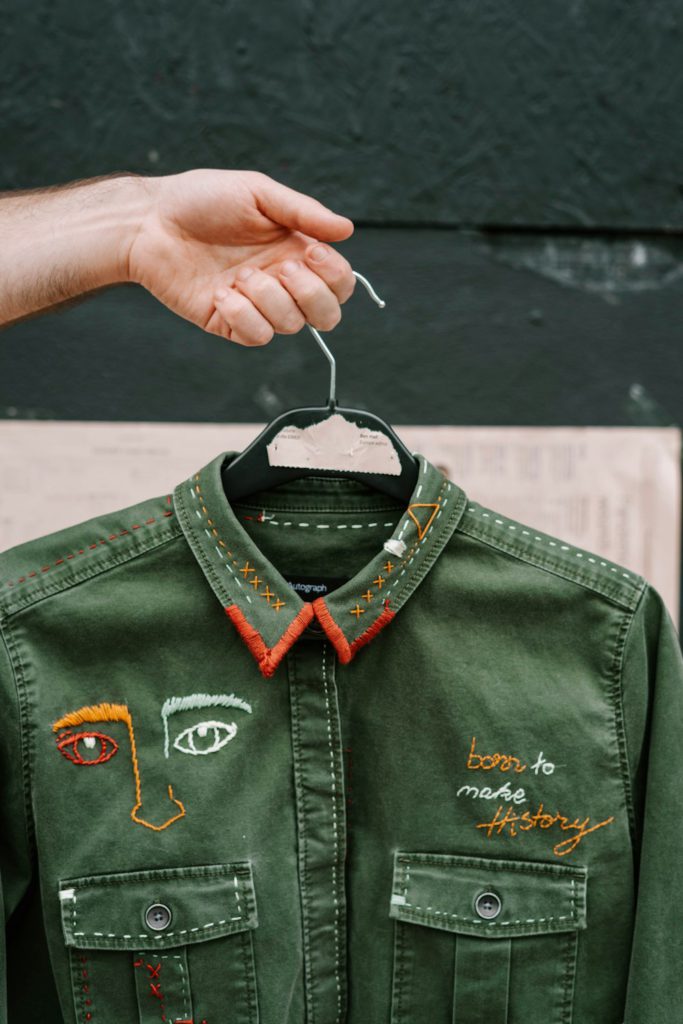
Upcycling can be a fun and rewarding hobby, and it can evolve from a passion project into a profitable business. However, diving into selling upcycled fashion requires careful consideration of several factors to ensure success and legality.
Legal and Safety Regulations
Depending on your location and the materials used, there may be legal and safety regulations to consider, mainly if you’re selling children’s clothing or items with potential safety hazards. Other legal and safety considerations you need to take into account include:
-
- Copyright and Branding: Consider copyright laws when upcycling designer or branded garments. Altering a piece doesn’t negate its original copyright, and using a brand’s logo without permission can lead to legal issues. An article published on IP Watchdog provides more insights into the copyright and branding concerns and challenges associated with upcycled products.
-
- Safety Standards: If selling children’s clothing, familiarize yourself with safety regulations concerning flammability, choking hazards, and other risks. Different countries have specific requirements to protect young consumers.
-
- Labeling Requirements: Many regions require clothing labels to provide material composition and care instructions. Understanding and complying with these requirements is essential.
Market Differentiation
Despite the allure of entering the upcycled fashion market, you must be prepared to face stiff competition. This burgeoning niche within the broader fashion industry is growing rapidly, fueled by increasing consumer awareness of environmental issues and a growing desire for unique, sustainable clothing options. Here are several strategies to navigate the competitive landscape effectively:
-
- Find Your Niche: The upcycling market is diverse, from vintage restorations to modern redesigns. Find a niche that aligns with your skills and passions—whether focusing on denim, outerwear, or accessories–that can help you stand out.
-
- Quality Over Quantity: Quality craftsmanship is highly valued in the handmade and upcycled market. Ensure your items are durable, well-made, and aesthetically pleasing to attract discerning customers.
-
- Tell a Story: Part of the appeal of upcycled fashion is the story behind each piece. Sharing the transformation process or the history of the materials used can enhance the value of your products.
-
- Offer Customization Services: Given the personal nature of upcycled fashion, offering bespoke or customization services can attract customers looking for something uniquely tailored to them. This provides a personalized experience and allows you to command higher pricing.
Marketing Strategy
Given the competitive landscape of the upcycled fashion market, crafting effective marketing strategies is essential to attract a devoted clientele, increase sales, and maintain a cohesive brand image. Here’s how you can achieve these goals:
-
- Online Presence: Leverage social media platforms and online marketplaces specialized in handmade or upcycled goods to reach a broader audience. High-quality photos and engaging stories about your creations can captivate potential buyers.
-
- Leverage High-Quality Visual Content: Visual storytelling is compelling in the fashion industry. Invest in high-quality photography that showcases the uniqueness and details of your pieces. Use these visuals across social media, your website, and online stores to capture attention and inspire potential customers.
-
- Local Community Engagement: Whether it’s through interactive workshops, pop-up events, or participating in sustainable fashion forums, engaging with your community can build meaningful connections and customer loyalty. Listening to feedback and involving your audience in the creative process can also provide valuable insights.
-
- Build Partnerships: Collaborating with other designers, artists, or brands can open up new opportunities and audiences for your upcycled fashion. These partnerships can range from joint collections to cross-promotional efforts on social media.
-
- Offer Limited Edition Pieces: Create limited edition items or capsule collections that infuse a sense of urgency and exclusivity. Promoting these limited runs can stimulate quick action from potential buyers, attract media attention, and set you apart from competitors who may only offer more generic options.
Conclusion
Upcycled fashion is one of the most compelling steps anyone can take to create a sustainable future in a world plagued by fast fashion and disposable clothing.
By embracing the principles of upcycling and incorporating DIY techniques into your wardrobe, you can reduce your environmental footprint while expressing your creativity and individuality.
Whether you’re a seasoned seamstress or a novice crafter, there are endless possibilities for transforming old garments into stylish new pieces that reflect your personal style.
So why not give it a try? With a bit of imagination and a willingness to experiment, you can breathe new life into your wardrobe and positively impact the planet.
Frequently Asked Questions
What is upcycling and how is it related to fashion?
Upcycling is the process of transforming old or unused items, such as clothing, into something new and of better quality. In the fashion context, it involves creating new garments or accessories from pre-existing ones, promoting sustainability and creativity.
How can I transform my old clothes into something new and stylish?
You can transform your old clothes by using upcycling techniques such as cutting, sewing, and embellishing to create unique pieces. There are many creative upcycling ideas and online tutorials available to guide you through the process.
What are some easy DIY tricks to upcycle clothes without using a sewing machine?
You can upcycle clothes without a sewing machine by using simple techniques like knotting, braiding, or adding fabric patches to give your old clothes a new look. There are plenty of ways to upcycle old clothes without needing advanced sewing skills.
Can I upcycle a wedding dress into everyday wear or other garments?
Yes, you can upcycle a wedding dress into everyday wear or other garments by cutting and reimagining its design. This process allows you to reuse the fabric and transform it into unique pieces that suit your style and preferences.
What are some creative ways to upcycle old t-shirts into something new and useful?
You can upcycle old t-shirts into various useful items such as tote bags, headbands, or woven rugs. By refashioning old t-shirts, you can give them a new purpose and contribute to reducing textile waste.
Are there any upcycling techniques suitable for beginners who want to transform their clothes?
Yes, there are many upcycling techniques suitable for beginners, such as simple cutting and tying methods or basic sewing projects. Upcycling is a great project for beginners to learn how to make their clothes last longer and create unique pieces.



